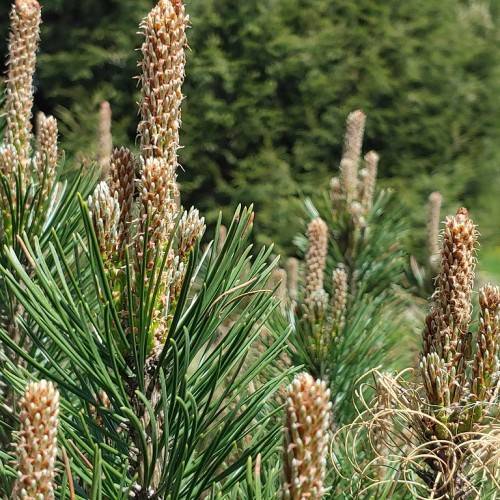
mugo pine
Pinus mugo 'Gordon Bentham'
Also Known As - Swiss mountain pineCycle:
Perennial
Watering:
Average
Hardiness Zone:
2 - 7
Flowers:
Flowers In Spring
Sun:
Full sun
Soil:
Acidic, Well-drained
Cones:
Yes
Leaf:
Yes
Growth Rate:
Low
Maintenance:
Low
Drought Tolerant:
Yes
Salt Tolerant:
Yes
Care Level:
Medium
watering
Mugo pine should be watered every 2 to 3 weeks during the growing season (spring through fall). Water thoroughly right around the base of the plant so that the root system is deeply moistened. Allow the soil to dry slightly between waterings, as mugo pine does not tolerate overly wet soil. Water restriction should be given during the winter months when growth has slowed down and the plants have entered dormancy.
sunlight
Mugo pine (Pinus mugo 'Gordon Bentham') prefers full sun, which means it should receive at least 6 hours of direct sunlight per day. For best growth, it should also receive 8 to 10 hours of full sun exposure daily during the summer months. The sun's intensity should be moderate to low during the hottest part of the afternoon in order to protect the needles from sunscald, which can damage the plant. Morning and late afternoon sun is best. During winter months, the pine should still receive direct sunlight to a certain degree. However, the amount of light should be decreased to protect the needles and stay within the recommended 6 to 8 hours of sunlight per day.
pruning
When it comes to pruning Mugo pine (Pinus mugo 'Gordon Bentham') it is important to keep it to a minimum. Pruning should only be done when absolutely necessary (when a branch is crossing another, is dead, or diseased). The best time to prune a Mugo pine is in the late spring, after the plant has had a chance to fully wake from its winter dormancy. when pruning, be mindful of the natural form of the Mugo pine that you are working with – many times it is easier to simply choose the best growing branches and perform light selective pruning to thin the appearance. If more drastic pruning is needed, make sure to do it slowly and carefully over the course of a few years. Also be sure to use clean, sharp gardening tools to avoid introducing disease into the plant.
